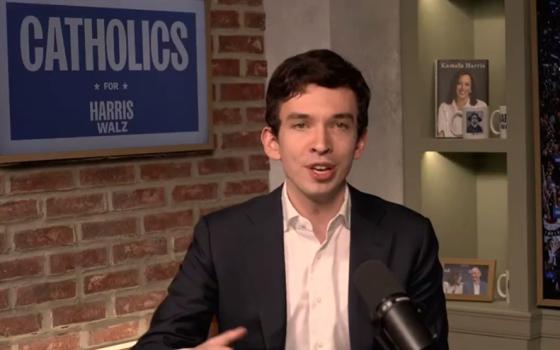
I have never seen the movie “Animal House.” I blame the Catholic church for this cultural deficiency.
You see, while all my high school friends were enjoying John Belushi’s antics in National Lampoon’s classic tale of fraternity hijinks, I had to stay home. In our house, before my sister and I were allowed to see any movie, my parents consulted the U.S. Catholic Conference list of movie ratings dutifully clipped from our diocesan newspaper and posted on the refrigerator.
The “Animal House” rating of “O” (morally offensive) meant no toga party for me.
The U.S. bishops’ conference, at usccb.org/movies, still rates movies and television shows based on their moral and entertainment values, giving special attention to human sexuality, depictions of the church and clergy, and the film’s overriding philosophy.
“Our classifications have always been intended as a guide for parents,” the office’s mission statement says. “Parents must be the ultimate arbiters in evaluating their child’s emotional, spiritual and moral development, and the appropriateness of any given film. Thoughtful adults are the best judges of their own tastes and values.”
It wasn’t always merely “advisory.”
Back in the 1930s, the explosion of moving pictures’ popularity had many religious folks, Catholics included, nervous about the moral and political threat immoral films surely posed to unsuspecting moviegoers. City censorship boards sprang up, Hollywood responded with its own self-censoring organization and Catholics formed the Legion of Decency, whose members took an oath to avoid and to protest immoral movies.
The fear was that movies would “corrupt and impair good morals,” as Pope Pius XI put it in his 1936 encyclical Vigilanti Cura. Not only did they present life in a “false light,” immoral movies seduced the young by inciting lust, providing occasions of sin and destroying the sanctity of marriage, according to the pope.
Since the very souls of the young -- and not-so-young -- were at stake, a little censorship seemed like a small price to pay.
Of course, the church also had a long history of censoring written and printed material via its infamous Index of Prohibited Books, which banned nearly 4,000 writings from 1564 until it was abolished in 1966. Among those labeled as heretical, superstitious and immoral or obscene were scientists Copernicus and Galileo, philosophers Sartre and Kant, poets Milton and Hugo, and theologians Luther and Calvin. Interestingly, so was St. Faustina Kowalska, the Polish mystic who founded the Divine Mercy devotion. Her writings spent 20 years on the Index before they were removed.
Though the Index is no more, the church still attempts to control the publication of books about scripture, theology, church history or morality through the imprimatur (“let it be printed”) process, though in practice only a minority of books apply for that designation.
And, sadly, the Vatican’s Congregation for the Doctrine of the Faith still condemns or “admonishes” (less severe) theologians it deems erroneous, such as Anthony de Mello and Jon Sobrino, or bans writers from teaching as Catholic theologians, such as Charles Curran and Roger Haight.
An investigation and ban can mean a lot of headaches, especially when the authors are priests or religious, but it also guarantees plenty of free publicity. Really, who had heard of Tissa Balasuriya before his Mary and Human Liberation was investigated in 1996?
Such offenses against freedom of the press today seem, well, medieval. To democratic societies, censorship is seen as a human rights issue, and those who practice it, such as radical Muslims or the Chinese government, are seen as oppressors. Not the best company for church authorities, who are supposed to be on the side of human rights victims.
Not only is censorship wrong, it’s practically impossible in today’s wired world, where someone is sure to post on the Web whatever is being suppressed. Then comes the inevitable bad press when the attempted censorship is exposed. Witness recent attempts to keep certain bishops’ statements and speeches from the public. Or attempts to prevent certain speakers from appearing at Catholic parishes, universities and other institutions. Those speakers’ views only get a wider hearing, thanks to the attempts to censor.
Of course, no freedom is absolute, and even censorship-free societies do not allow printed or broadcast information that is slanderous or libelous. And censorship by the church originally had the noble goal of safeguarding the faith and morals of the institution and its members.
But censorship is too often about abuse of power, not paternal protection. And even when motives are pure, what happens when censored material turns out to be correct? There are those who still mock the church for opposing the idea that the earth revolves around the sun. Who knows, maybe Sobrino is right about liberation theology and Balasuriya is dead on about original sin. We’ll never know if we can’t read and discuss their ideas openly.
As a mom to two preschoolers, I am very careful about what my children read and see on TV, because I want to protect them from things that would harm them. I may even consult the bishops’ conference or other guides for advice about movies.
Too bad the church treats adult Catholics as if we were preschoolers.
[Heidi Schlumpf is the author of While We Wait: Spiritual and Practical Advice for Those Trying to Adopt (ACTA Publications).]




